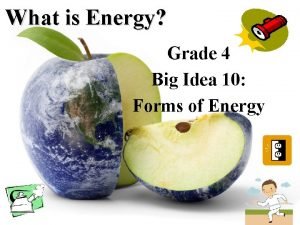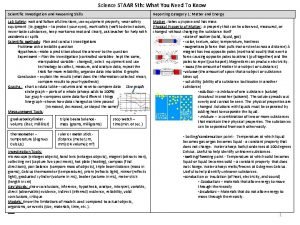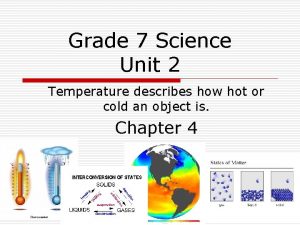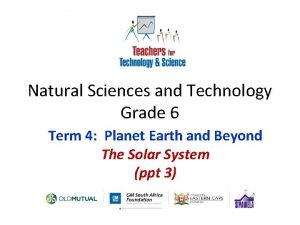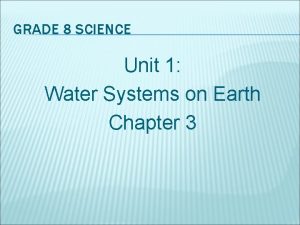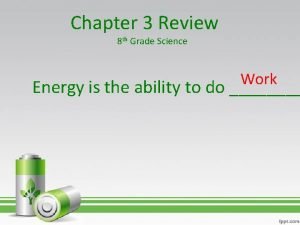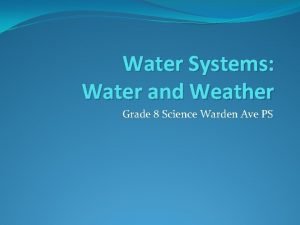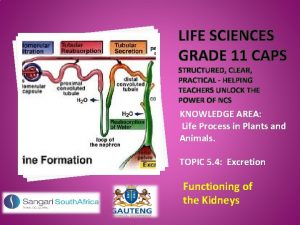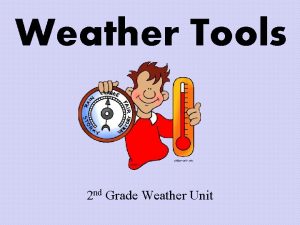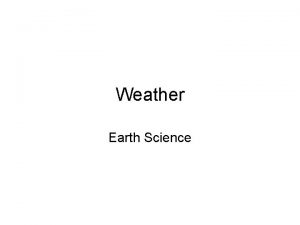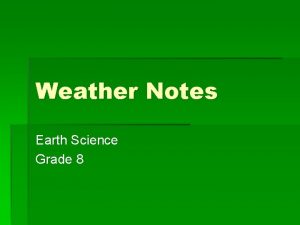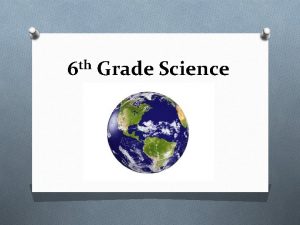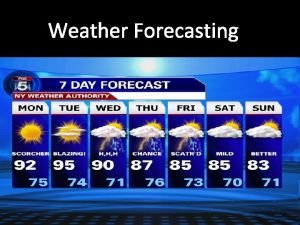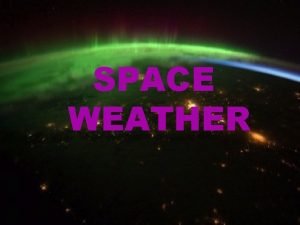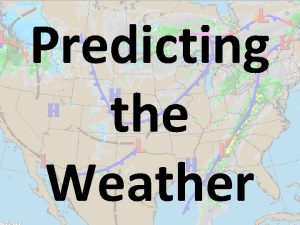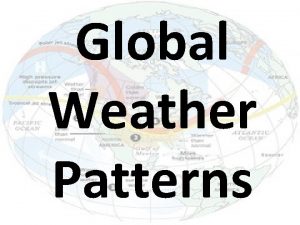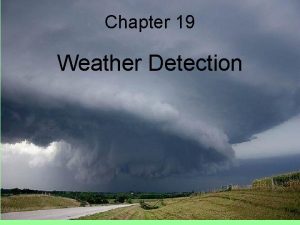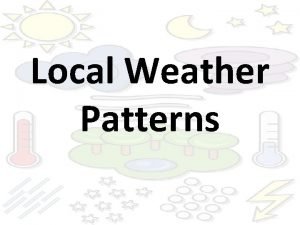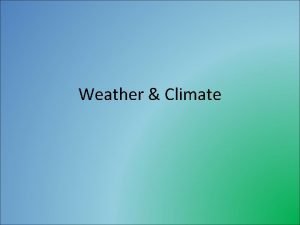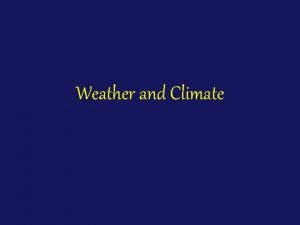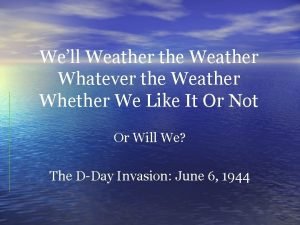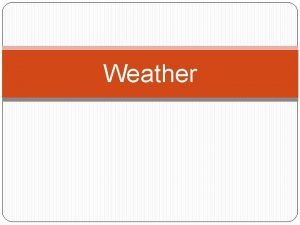Weather Grade 5 Science What is Weather Weather





















































- Slides: 53

Weather Grade 5 Science

What is Weather? • Weather is the condition of the Earth’s Atmosphere at a given time. • It can change drastically in a 24 hour period.

What causes Weather? • All elements of weather are the direct result of energy from the sun. • The sun’s rays hit earth and the land absorbs the heat unevenly. • This uneven heating causes changes in weather.

What does weather include? • Air temperature • Cloud cover • Amount of sunlight • Relative humidity • Precipitation • Wind speed • Wind direction

Temperature • Temperature is amount of heat in a substance. Expressed in degrees Fahrenheit or Centigrade (Celsius) • Temperature is measure by an instrument called a thermometer. • BLM#1 -measuring temperature around the room.

The Earth’s Atmosphere • It is a layer of air that surrounds the earth. • It is made up of many gases. Mostly Nitrogen, Carbon Dioxide and Oxygen.


A Bunch of Hot Air. • Cold air contracts or sinks. • The air molecules get closer together, which makes the air heavier or more dense. • Hot air expands or rises. The molecules get further apart, become less dense and they get lighter.

Air Circulation • Since warm air rises, the upper part of the room is the warmest. The coolest part of the room would be closer to the floor. • BLM #2 Classroom Temperature


Convection Currents • Is the act of a cold fluid or gas pushing a warmer, more dense fluid or gas out of the way.


Other examples of convection • A fridge door • The door to your house • Ovens

Wind Spiral • BLM # 3 • Why is the spiral able to turn? • The hot air “rising” is turning the spiral.

Wind • Wind is moving air in the atmosphere. • Air is always moving from high pressure to low pressure. • The strongest winds are tornadoes, the air pressure is extremely low.

How to measure wind speed • Wind speed is measure in kilometres per hour (kph). We use a device called an anemometer. • BLM #5 • Wind Direction is always stated in terms of where the wind is coming from.

Measuring Wind Direction • Wind Sock • Weathervane

Beaufort Scale • The Beaufort scale is an empirical measure for describing wind intensity based mainly on observed sea conditions. Its full name is the Beaufort wind force scale. • BLM #12 b

Humidity- Moisture in the Air • The sun heats up the water on land causes evaporation. • The moisture the is in the air is called humidity. • Saturated is when the air has too much moisture and cannot hold anymore. • BLM #6

The Water Cycle

The Water Cycle • The sun heats up the water- evaporation • The water vapor (gas) condenses into clouds • The clouds become saturated and precipitation is the result. • The precipitation pools in lakes, oceans and rivers. Waiting to evaporate again.


Relative Humidity • It is the ratio of how much moisture is in the air and how much the air can hold. • 50% humidity means the air is holding 50% moisture • BLM #7

Precipitation • When there is too much moisture, the water will fall as precipitation. • Precipitation will fall in two main forms: rain or snow depending on the temperature of the air through which the moisture will fall. • Other forms of precipitation are sleet and hail.

Forms of Precipitation

Snow • If the air is cooled • • below the freezing point of water, the condensing moisture is quickly freeze into ice crystals. The ice crystals join to make snowflakes Snowflakes are always six sided.

Rain • When droplets of moisture join together becoming heavy enough to fall to the ground.

Hail • Formed in cumulonimbus (storm) clouds. They are frozen droplets of moisture. • BLM #9

Sleet • When falling rain starts off in warmer air, but passes through air below freezing, the rain drops cool and freeze onto surfaces when they hit the ground.

Facts on Precipitation • It takes 10 centimetres of snow to make one centimetre of rain. • Dew is moisture in the air cools off at night. In the morning it is found on everything. In colder temperatures, dew is frost.

Air Pressure • The force that is applied on everything on the Earth caused by the weight of the air. • Air particles are mobile, the exert pressure on objects. • High air pressure brings warm, dry air. Low air pressure brings rain or moisture

Air Pressure • Air pressure can change quickly, ie- when a storm comes in. • There are three factors that affect air pressure: altitude, air mass temperature and the amount of moisture in the air. • A Barometer is used to measure air pressure.

Clouds • Clouds come in many shapes and forms. • Some are high in the sky, while others are so low they touch the ground. • No matter what shape or elevation, clouds form the same way, by having water vapor condense onto small solid particles like dust, sea salt, and pollution

Clouds • Clouds serve several important functions. • They provide rain and snow. • They also help retain heat, so it doesn’t escape quickly back into space. • On hot days, clouds provide shade

Types of Clouds • There are Four main types of clouds • Cirrus- found high in the atmosphere • Cumulus- found in mid-atmosphere • Stratus- found in the low atmosphere • Nimbus- storm clouds.

Cirrus • They are thin, wispy clouds blown by high winds into long streamers. • They usually mean fair to pleasant wheather.

Cumulus • They are puffy clouds that sometimes look like pieces of floating cotton • They can develop into a giant cumulonimbus, which is a thunderstorm cloud

Stratus • are uniform grayish clouds that often cover the entire sky. • They resemble fog that does not reach the ground. • Usually no precipitation falls from stratus clouds, but sometimes they may drizzle.

Nimbus (Cumulonimbus) • They are thunderstorm clouds that form if cumulus clouds continue to grow vertically. • Lightning, thunder, and even violent tornadoes are associated with the cumulonimbus.


Can you identify these clouds?

Seasons • The Earth orbits around the sun. • The Earth tilts on its axis 23. 5 degrees. • The area of the Earth, that heats up more, is closer to the sun.

Seasons • When Canada is tilted • • away from the sun, it is winter. When Canada is tilted towards the sun, it is summer. Spring and Autumn are the in between orbits.

Daylight • The Earth turns on its axis, one complete rotation in one day. (24 hours) • The Sun rises in the east and sets in the west • The amount of daylight is related to the Earth’s orbit around the sun. • Spring and summer have more daylight hours, because we are tilted towards the sun.

Daylight • The sun give off sunlight, that heats the Earth. • Direct Sunlight is hotter than indirect sunlight. • What time of the day is the hottest?

Noon • The sun is directly over our heads at lunch time. • At noon you do not have hardly any shadow. • In the morning and evening, sunlight is spread out more. • You have more of a shadow, because the sunlight has to travel a greater distance.

Hot Sun, Cool Sun • Use BLM 14 and BLM 15 to measure the heat of the sun, at different times of the day. • When are the sun’s rays most spread out? • When is it the warmest?

Predicting the Weather • http: //weather. msn. com/local. aspx? wealoc ations=wc: CAXX 0126 • Monitor the weather for a week. Use BLM #12. • Use www. theweathernetwork. com

Examples of Weather Forecasts • What do all the numbers mean?

Forecasting the Weather • You have keep track of the weather for ten days. • Was the weather forecast accurate? • Why is it so difficult to predict the weather?


Factors that influence weather in different areas. • Land Elevation • Location- lattitude and longitude • The sun • Cloud cover • Air pressure • Earth’s orbit (seasons)

 Science is my favourite subject because
Science is my favourite subject because Grading system in college
Grading system in college Jump rope songs cinderella
Jump rope songs cinderella Culinary
Culinary Grades of milk
Grades of milk Grading of grapes
Grading of grapes Metamorphic grade
Metamorphic grade What is energy grade 4
What is energy grade 4 8th grade science eog
8th grade science eog 8th grade science staar review reporting category 4
8th grade science staar review reporting category 4 A student examines the winged insect shown below
A student examines the winged insect shown below Flow diagram of the energy system
Flow diagram of the energy system Grade 6 natural science matter and materials
Grade 6 natural science matter and materials Technology grade 7 term 2 notes
Technology grade 7 term 2 notes The biosphere grade 7
The biosphere grade 7 Natural science and technology grade 6 term 3
Natural science and technology grade 6 term 3 Natural science grade 5
Natural science grade 5 Grade 11 animal nutrition
Grade 11 animal nutrition Grade 10 life science transpiration practical
Grade 10 life science transpiration practical Science jeopardy questions 7th grade
Science jeopardy questions 7th grade Earth science grade 9
Earth science grade 9 Science staar review 8th grade
Science staar review 8th grade Grade 7 science unit 2
Grade 7 science unit 2 Saturated and unsaturated solutions grade 7
Saturated and unsaturated solutions grade 7 Science staar review
Science staar review 8th grade science mcas review
8th grade science mcas review Grade 4 natural science test term 3
Grade 4 natural science test term 3 Introduction of food web
Introduction of food web Science jeopardy 8th grade
Science jeopardy 8th grade 8th grade science weebly
8th grade science weebly Planet earth and beyond grade 7
Planet earth and beyond grade 7 Natural science grade 7 term 3
Natural science grade 7 term 3 Natural science grade 6 solar system
Natural science grade 6 solar system Different ecosystems grade 6
Different ecosystems grade 6 Natural science grade 5 term 4
Natural science grade 5 term 4 Plants and animals on earth grade 5
Plants and animals on earth grade 5 Computer grade 10
Computer grade 10 Natural science grade 6 solar system
Natural science grade 6 solar system Switchzoo
Switchzoo What is matter grade 7
What is matter grade 7 Natural science and technology grade 6 term 4
Natural science and technology grade 6 term 4 Natural science grade 6 term 3
Natural science grade 6 term 3 Organic compounds grade 10 life science
Organic compounds grade 10 life science Grade 8 water systems test
Grade 8 water systems test Discovering science 8
Discovering science 8 Examples of pure substances
Examples of pure substances Chapter 3 review 8th grade science
Chapter 3 review 8th grade science Www middleschoolscience com 2008
Www middleschoolscience com 2008 Grade 8 science water systems
Grade 8 science water systems Useful and wasted energy grade 7
Useful and wasted energy grade 7 Energy and change grade 7
Energy and change grade 7 Anemophily
Anemophily Malpighian body
Malpighian body Life science grade 11 kidney practical
Life science grade 11 kidney practical







